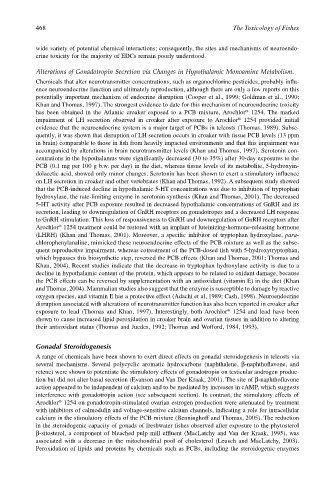Page 488 - The Toxicology of Fishes
P. 488
468 The Toxicology of Fishes
wide variety of potential chemical interactions; consequently, the sites and mechanisms of neuroendo-
crine toxicity for the majority of EDCs remain poorly understood.
Alterations of Gonadotropin Secretion via Changes in Hypothalamic Monoamine Metabolism.
Chemicals that alter neurotransmitter concentrations, such as organochlorine pesticides, probably influ-
ence neuroendocrine function and ultimately reproduction, although there are only a few reports on this
potentially important mechanism of endocrine disruption (Cooper et al., 1999; Goldman et al., 1990;
Khan and Thomas, 1997). The strongest evidence to date for this mechanism of neuroendocrine toxicity
®
has been obtained in the Atlantic croaker exposed to a PCB mixture, Arochlor 1254. The marked
impairment of LH secretion observed in croaker after exposure to Arochlor 1254 provided initial
®
evidence that the neuroendocrine system is a major target of PCBs in teleosts (Thomas, 1989). Subse-
quently, it was shown that disruption of LH secretion occurs in croaker with tissue PCB levels (13 ppm
in brain) comparable to those in fish from heavily impacted environments and that this impairment was
accompanied by alterations in brain neurotransmitter levels (Khan and Thomas, 1997). Serotonin con-
centrations in the hypothalamus were significantly decreased (30 to 35%) after 30-day exposures to the
PCB (0.1 mg per 100 g b.w. per day) in the diet, whereas tissue levels of its metabolite, 5-hydroxyin-
dolacetic acid, showed only minor changes. Serotonin has been shown to exert a stimulatory influence
on LH secretion in croaker and other vertebrates (Khan and Thomas, 1992). A subsequent study showed
that the PCB-induced decline in hypothalamic 5-HT concentrations was due to inhibition of tryptophan
hydroxylase, the rate-limiting enzyme in serotonin synthesis (Khan and Thomas, 2001). The decreased
5-HT activity after PCB exposure resulted in decreased hypothalamic concentrations of GnRH and its
secretion, leading to downregulation of GnRH receptors on gonadotropes and a decreased LH response
to GnRH stimulation. This loss of responsiveness to GnRH and downregulation of GnRH receptors after
Arochlor 1254 treatment could be restored with an implant of luteinizing-hormone-releasing hormone
®
(LHRH) (Khan and Thomas, 2001). Moreover, a specific inhibitor of tryptophan hydroxylase, para-
chlorophenylanaline, mimicked these neuroendocrine effects of the PCB mixture as well as the subse-
quent reproductive impairment, whereas cotreatment of the PCB-dosed fish with 5-hydroxytryptophan,
which bypasses this biosynthetic step, reversed the PCB effects (Khan and Thomas, 2001; Thomas and
Khan, 2004). Recent studies indicate that the decrease in tryptophan hydroxylase activity is due to a
decline in hypothalamic content of the protein, which appears to be related to oxidant damage, because
the PCB effects can be reversed by supplementation with an antioxidant (vitamin E) in the diet (Khan
and Thomas, 2004). Mammalian studies also suggest that the enzyme is susceptible to damage by reactive
oxygen species, and vitamin E has a protective effect (Adachi et al, 1989; Cash, 1998). Neuroendocrine
disruption associated with alterations of neurotransmitter function has also been reported in croaker after
®
exposure to lead (Thomas and Khan, 1997). Interestingly, both Arochlor 1254 and lead have been
shown to cause increased lipid peroxidation in croaker brain and ovarian tissues in addition to altering
their antioxidant status (Thomas and Juedes, 1992; Thomas and Wofford, 1984, 1993).
Gonadal Steroidogenesis
A range of chemicals have been shown to exert direct effects on gonadal steroidogenesis in teleosts via
several mechanisms. Several polycyclic aromatic hydrocarbons (naphthalene, β-naphthoflavone, and
retene) were shown to potentiate the stimulatory effects of gonadotropin on testicular androgen produc-
tion but did not alter basal secretion (Evanson and Van Der Kraak, 2001). The site of β-naphthoflavone
action appeared to be independent of calcium and to be mediated by increases in cAMP, which suggests
interference with gonadotropin action (see subsequent section). In contrast, the stimulatory effects of
®
Arochlor 1254 on gonadotropin-stimulated ovarian estrogen production were attenuated by treatment
with inhibitors of calmodulin and voltage-sensitive calcium channels, indicating a role for intracellular
calcium in the stimulatory effects of the PCB mixture (Benninghoff and Thomas, 2005). The reduction
in the steroidogenic capacity of gonads of freshwater fishes observed after exposure to the phytosterol
β-sitosterol, a component of bleached pulp mill effluent (MacLatchy and Van der Kraak, 1995), was
associated with a decrease in the mitochondrial pool of cholesterol (Leusch and MacLatchy, 2003).
Peroxidation of lipids and proteins by chemicals such as PCBs, including the steroidogenic enzymes

